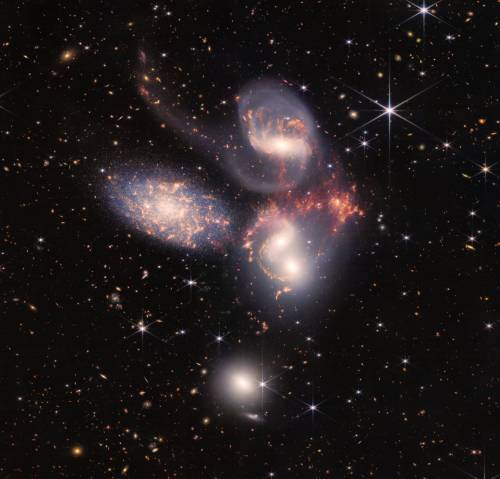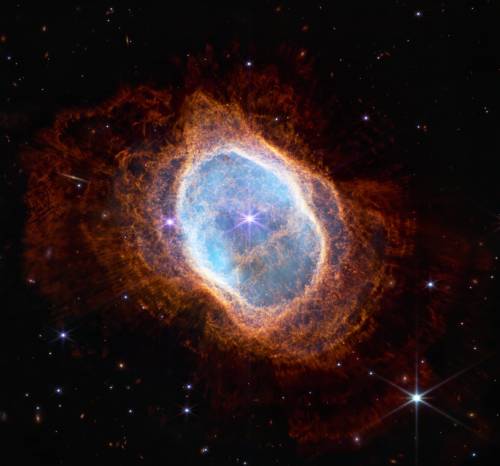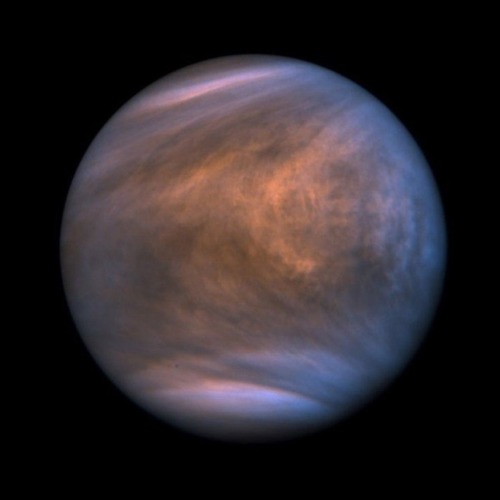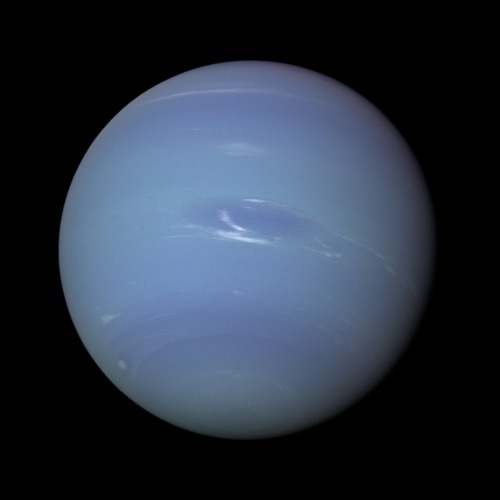A Dusty Fingerprint In Space
A Dusty Fingerprint in Space

A new image from NASA's James Webb Space Telescope reveals a remarkable cosmic sight: at least 17 concentric dust rings emanating from a pair of stars. Just 5,300 light-years from Earth, the star duo are collectively known as Wolf-Rayet 140. Each ring was created when the two stars came close together and their stellar winds (streams of gas they blow into space) collided so forcefully that some of the gas was compressed into dust. The stars' orbits bring them together about once every eight years, and forms a half-shell of dust that looks like a ring from our perspective. Like a cosmic fingerprint, the 17 rings reveal more than a century of stellar interactions—and the "fingerprint" belonging to Wolf-Rayet 140 may be equally unique. Other Wolf-Rayet stars produce dust, but no other pair are known to produce rings quite like Wolf-Rayet 140.
Learn more about Wolf-Rayet 140.
Make sure to follow us on Tumblr for your regular dose of space!
More Posts from Of-finite-jurisdiction and Others

Zeta Ophiuchi: A Star With a Complicated Past via NASA https://ift.tt/78Esywl



NASA’s Webb Space Telescope Reveals Astounding, Unprecedented Views of the Universe

NGC 6960, Witch’s Broom
![Screenshot from nebula Wikipedia page: The "Pillars of Creation" from the Eagle Nebula. Evidence from the Spitzer Space Telescope suggests that the pillars may already have been destroyed by a supernova explosion, but the light showing us the destruction will not reach the Earth for another millennium.[1]](https://64.media.tumblr.com/b10fae13b89258a4bbd4b2cd7cf10646/939e648398194b92-95/s500x750/dd77cb9b6f24b0eaca6ca04b691a327c71641d09.jpg)
btw . insane little wikipedia caption for everyone’s consideration also

Clearest image ever taken of Venus.
source: https://photojournal.jpl.nasa.gov/targetFamily/venus



Venus, Callisto (Jupiter’s moon), Neptune
Why is this heat so hot 😩

NGC 6995: The Bat Nebula : Do you see the bat? It haunts this cosmic close-up of the eastern Veil Nebula. The Veil Nebula itself is a large supernova remnant, the expanding debris cloud from the death explosion of a massive star. While the Veil is roughly circular in shape and covers nearly 3 degrees on the sky toward the constellation of the Swan (Cygnus), NGC 6995, known informally as the Bat Nebula, spans only ½ degree, about the apparent size of the Moon. That translates to 12 light-years at the Veil’s estimated distance, a reassuring 1,400 light-years from planet Earth. In the composite of image data recorded through narrow band filters, emission from hydrogen atoms in the remnant is shown in red with strong emission from oxygen atoms shown in hues of blue. Of course, in the western part of the Veil lies another seasonal apparition: the Witch’s Broom Nebula. via NASA

NGC 1365, Heart of the Galaxy
-
 skitterspam reblogged this · 2 weeks ago
skitterspam reblogged this · 2 weeks ago -
 tofinusmagnus liked this · 1 month ago
tofinusmagnus liked this · 1 month ago -
 blacklicoriceaddict liked this · 3 months ago
blacklicoriceaddict liked this · 3 months ago -
 madmaenad reblogged this · 5 months ago
madmaenad reblogged this · 5 months ago -
 whirlberry reblogged this · 6 months ago
whirlberry reblogged this · 6 months ago -
 whirlberry liked this · 6 months ago
whirlberry liked this · 6 months ago -
 siachti reblogged this · 7 months ago
siachti reblogged this · 7 months ago -
 siachti liked this · 7 months ago
siachti liked this · 7 months ago -
 melocosmos reblogged this · 7 months ago
melocosmos reblogged this · 7 months ago -
 melocosmos liked this · 7 months ago
melocosmos liked this · 7 months ago -
 likeinfinitea reblogged this · 7 months ago
likeinfinitea reblogged this · 7 months ago -
 joomju liked this · 7 months ago
joomju liked this · 7 months ago -
 allatariel liked this · 7 months ago
allatariel liked this · 7 months ago -
 oh-nostalgiaa liked this · 7 months ago
oh-nostalgiaa liked this · 7 months ago -
 melyzard reblogged this · 7 months ago
melyzard reblogged this · 7 months ago -
 i-am-a-moonchild reblogged this · 7 months ago
i-am-a-moonchild reblogged this · 7 months ago -
 ace-bucket liked this · 8 months ago
ace-bucket liked this · 8 months ago -
 deafening-radio-silence reblogged this · 8 months ago
deafening-radio-silence reblogged this · 8 months ago -
 wingsr liked this · 11 months ago
wingsr liked this · 11 months ago -
 moggiemutt liked this · 11 months ago
moggiemutt liked this · 11 months ago -
 melyzard liked this · 11 months ago
melyzard liked this · 11 months ago -
 rampant-masochism liked this · 1 year ago
rampant-masochism liked this · 1 year ago -
 cedricredwood reblogged this · 1 year ago
cedricredwood reblogged this · 1 year ago -
 lilaccatholic liked this · 1 year ago
lilaccatholic liked this · 1 year ago -
 moethh liked this · 1 year ago
moethh liked this · 1 year ago -
 saint-augustines-pears reblogged this · 1 year ago
saint-augustines-pears reblogged this · 1 year ago -
 saint-augustines-pears liked this · 1 year ago
saint-augustines-pears liked this · 1 year ago -
 verpineshatterrifle reblogged this · 1 year ago
verpineshatterrifle reblogged this · 1 year ago -
 verpineshatterrifle liked this · 1 year ago
verpineshatterrifle liked this · 1 year ago -
 godsfavoritespecialangel liked this · 1 year ago
godsfavoritespecialangel liked this · 1 year ago -
 sulphuric-glue liked this · 1 year ago
sulphuric-glue liked this · 1 year ago -
 brapclinic liked this · 1 year ago
brapclinic liked this · 1 year ago -
 weirdpolis liked this · 1 year ago
weirdpolis liked this · 1 year ago -
 fartyrobbins liked this · 1 year ago
fartyrobbins liked this · 1 year ago -
 fartyrobbins reblogged this · 1 year ago
fartyrobbins reblogged this · 1 year ago -
 long-live-the-gobop liked this · 1 year ago
long-live-the-gobop liked this · 1 year ago -
 why-bless-your-heart reblogged this · 1 year ago
why-bless-your-heart reblogged this · 1 year ago -
 halogen888 liked this · 1 year ago
halogen888 liked this · 1 year ago -
 braveulyses liked this · 1 year ago
braveulyses liked this · 1 year ago -
 manofmydaydreams reblogged this · 1 year ago
manofmydaydreams reblogged this · 1 year ago -
 theo-brightside reblogged this · 1 year ago
theo-brightside reblogged this · 1 year ago -
 manofmydaydreams liked this · 1 year ago
manofmydaydreams liked this · 1 year ago -
 elmaxlys reblogged this · 1 year ago
elmaxlys reblogged this · 1 year ago -
 dukerandom liked this · 1 year ago
dukerandom liked this · 1 year ago -
 crybabydollsworld liked this · 1 year ago
crybabydollsworld liked this · 1 year ago -
 underscoredurl liked this · 1 year ago
underscoredurl liked this · 1 year ago -
 spikycritter liked this · 1 year ago
spikycritter liked this · 1 year ago -
 feminineurgetokill reblogged this · 1 year ago
feminineurgetokill reblogged this · 1 year ago

Finn OFJ’s space blog. Do you love space?? you better. or else
39 posts

